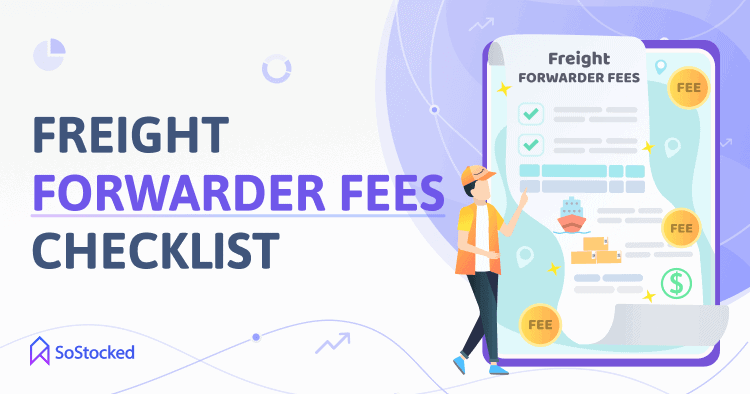
Freight Forwarder Fees Checklist
How To Read An Invoice & Avoid Duplicate Charges
With shipping prices increasing and margins shrinking, it’s time to look for new ways to reduce costs and make sure you aren’t overpaying on freight fees that further hurt your profits.
Do you have duplicate charges? Are you being overcharged by unethical carriers and freight forwarders? Or perhaps just due to billing errors that need to be corrected?
For instance, wrong calculations of cargo weight, dimensions, freight class, and pallet count can result in overcharges. Being charged in Euro currency instead of USD can also cause you to pay more.
So whether you’re hiring a new freight forwarder or reviewing the invoicing from your current one, you need to know how to break down the charges once you receive their invoices.
If you’re currently paying your freight forwarding invoice without reviewing the Bill of Lading (BoL) or other backup documentation for accuracy, you may be missing important details that could cost you. Don’t know how to read, understand or even know what a BoL is? That’s alright. That’s why I’ve put this article together.
As a quick disclaimer, always consult your freight forwarder on what is best for you. This post is meant to empower you to better understand this subject so that you can ask intelligent questions to choose what is best for your business. However, as this subject includes legally binding documents, it is always best to consult your business professionals such as a lawyer or your own freight forwarder for the best advice.
Read on to learn how to read and understand your freight forwarder invoices so that errors don’t pile up over time without you noticing.
In this Freight Forwarder Fees guide, we’ll take a look at:
- What Is A Freight Forwarder Invoice?
- Why Is A Freight Invoice Important?
- How To Read A Freight Forwarder Invoice
- Freight Invoice Sample
- What Is A Bill Of Lading (BoL)?
- Master Bill Of Lading Vs. House Bill Of Lading
- Non-Negotiable Vs. Negotiable BoL
- Other Types of Bills of Lading
- How To Read A Bill Of Lading
- Bill Of Lading Sample
- Differences Between Freight Invoice And Bill Of Lading
- Shipping Fees That Impact Freight Costs
- Freight Audit Checklist
- Automate Your Inventory Tracking Process With SoStocked
- Stay In Control Of Your Shipping Costs
What Is A Freight Forwarder Invoice?
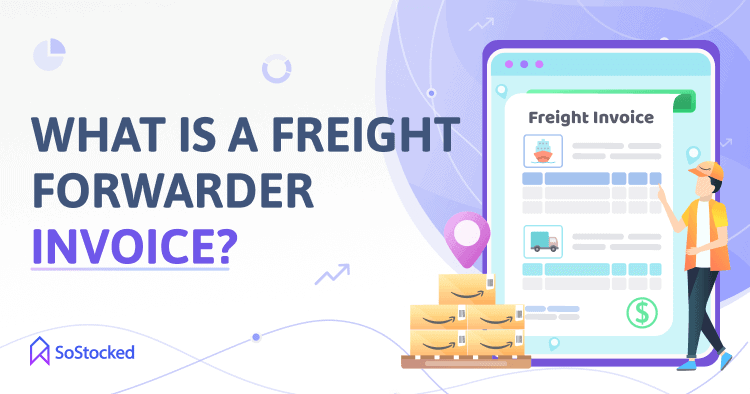
Also known as a freight bill, a freight invoice is a document that shipping service providers generate to summarize a financial transaction with customers. The details included in freight invoices may vary depending on the type of shipment involved, such as Full Container Load (FCL), Less than Container Load (LCL), Pier to Pier (a quote that only covers export pier to import pier), Door to Door (shipment is picked up by the freight forwarder at the door of the shipper and delivered to the recipient’s door), Full Truck Load (FTL), Less than Truck Load (LTL), among others.
But in most cases, financial documents like freight invoices usually reflect the product name, quantity being shipped, price per unit of measure, a subtotal for the items shipped, and additional line items for the freight rate and taxes. The lower half of the invoice is usually reserved for specific instructions, including payment terms. For example, a “Payment Terms” section to indicate where (bank transfer, online, mail, etc.) and when the payment should be made (e.g., within 10 days upon receipt of the invoice). The freight invoice must be sent to whoever is responsible for paying the shipment, and the carrier must keep a copy.
Why Is A Freight Invoice Important?
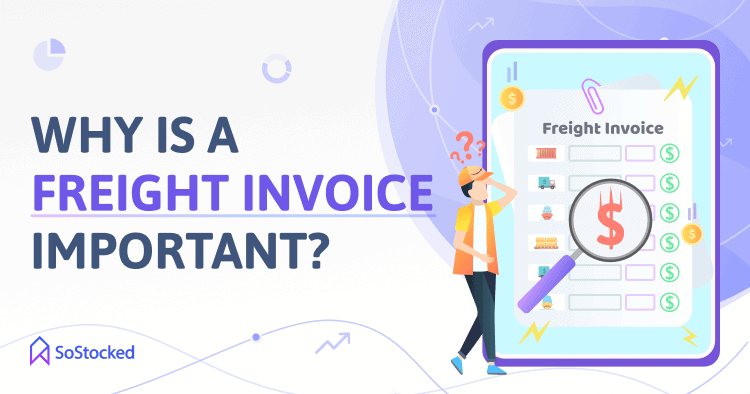
Freight bills can provide rich insights into your freight spend. When doing a spend analysis, financial advisors, accountants, or freight auditors (those who examine, adjust, and verify freight invoices for accuracy) can use the data from this document to find mismatches between the shipment details and final invoiced amounts and resolve them.
For example, you might be quoted $10,000 for a 40ft container and then end up paying $13,000 due to miscalculations in your cargo’s weight or dimensions.
Simply put, freight invoices are an excellent source of information during an examination of your financial records, where freight charges are reconciled against freight contracts and tariffs.
How To Read A Freight Forwarder Invoice
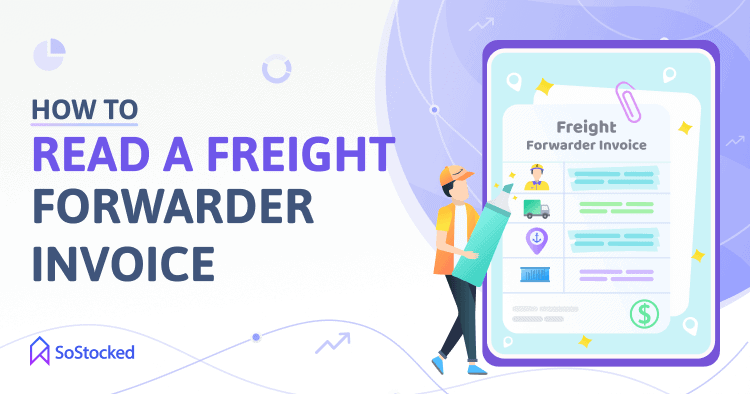
In order to fully understand the charges listed on your freight forwarder invoice and bill of lading, it’s essential to learn how to read them. We will start here with FF invoices and then dive deeper further on.
To begin, a freight invoice can be divided into three sections:
Carrier and Customer Information
This section details the name and address of the following parties:
Carrier
The party responsible for transporting your goods from the source country to the final destination. They also take care of all the documents and customs requirements necessary to move your cargo internationally.
Shipper
Also called the exporter/sender/supplier, this party is the supplier or owner of your cargo before it arrives at its final destination. They are also responsible for preparing your shipment for shipping, including supplying the commercial invoice to indicate the value of the goods as well as the packing list to indicate the carton count, weight, dimensions and product description.
Consignee
A consignee is generally the recipient, importer, and the owner of the shipped goods. This person or entity is also the one legally required to be present to accept the shipment upon delivery so it is common, especially in eCommerce, for the consignee to be a third party, such as a third party warehousing company, that the owner of the goods assigns to receive the shipment on his behalf.
Invoice Details
In this section of the invoice, you can see the unique invoice number that your freight forwarder has assigned to your cargo. It also includes the invoice date on which it was generated and a due date for payment.
Freight Details
This section is usually laid out in a table format with multiple columns. A carrier or freight forwarder may have a column for:
- Item. A line item for service, accessorial charges, product, discount, and so on. An additional line item may also be added for taxes.
- Item Description (the carrier describes what you’re being charged for)
- Unit price (e.g., the cost to transport a pallet of dog food or per volumetric weight)
- Quantity (e.g., number of pallets being transported)
- Amount
Freight Charges
Freight rates can be determined in multiple ways, including per-pallet and weight-based pricing systems (more on that later). In most cases, carriers charge shippers more for transporting their shipments over greater distances. They also charge fees for accessorial services (AKA add-ons) and a fuel surcharge to account for gas price fluctuations.
Sea freight invoices usually show two types of charges: ocean-based and land-based rates.
Ocean-based fees typically include:
- Sea Freight Base Rate – The rate of transporting a container from Point A to Point B via sea freight.
- Bunker Adjustment Factor (BAF). A bunker is a large container for storing fuel during shipping. As the prices of fuel are volatile, carriers typically charge BAF to account for the fluctuations in global bunker costs.
- International Ship and Port Security (ISPS). The ISPS is a set of security measures applicable to ships and port facilities around the globe. This allows countries to monitor and detect the activity of people involved in a shipping operation at their ports, to ensure there are no security threats. However, implementation of ISPS means additional expenses for shipping companies, as they will need to employ qualified and trained personnel capable of enforcing these strict security measures. So, they may charge you an ISPS surcharge to help cover these costs.
- Currency Adjustment Factor (CAF) fee. US Dollar, Euro and Pound are the most common currencies involved in international shipping. But since these currencies fluctuate regularly, the shipping industry sometimes charges customers a fee to cover monetary losses due to this fluctuation.
- On-Carriage Charge (OCC). OCC refers to the fee for connecting transportation needed beyond the point at which the primary mode of transportation stops. For example, carriage beyond an ocean port, airport, rail head, and so on. It would be any inland movement beyond the destination terminal or port.
- Chassis Usage Surcharge (CUS). CUS is a fee for the use of a chassis along with the shipping container to facilitate overland transportation of cargo from the shipper’s factory or location to the port.
Basic Land-Based Rates
- Terminal Handling Charges (THC). This fee refers to the costs involved with handling your cargo at a specific terminal within a specific terminal in a specific country.
- Documentation Fee, i.e., the cost of processing important documents like Certificate of Origin, Booking Confirmation, Material Safety Data Sheet, and so on.
As for haul freight (FTL and LTL), the key details you’ll see on trucking freight invoices usually include:
- Names of the shipper (supplier/sender/exporter), carrier (shipping company), and consignee (receiver/buyer/importer)
- Date of the shipment
- Origin and destination points
- The number of packages
- Weight, volume, or measurement of freight
- Applicable fees, including additional charges
- Total amount due
- Transportation route(s) and name of each carrier taking part in the transportation of the freight
- Any transfer point(s) through which cargo passed
- Address where payment must be made
Note: It’s vital that the information specified on your invoice matches or closely matches the ones noted on your bill of lading. Checking these two documents’ freight details will help you to easily link them together during freight audits. Linking them together allows you to check for any inaccuracies on both documents. If your freight invoice says you’re being charged for 20 cartons, but your BoL indicates only 18 cartons arrived, you can use the BoL as documentation to pay only a portion of the billed amount or to request a credit for the lost cartons.
Bonus: It’s also good practice to know the most common terms used on a freight invoice to understand freight charges better. These terms include:
Actual weight
This is exactly what your cargo weighs, including pallets and packaging.
Dimensional weight
Also known as DIM weight, cubed weight, or volumetric weight, dimensional weight is the amount of space a shipment occupies in relation to its actual weight. See “Weight and Volume” section below for more information.
Billable weight
Also known as chargeable weight, billable weight is the weight freight forwarders use to calculate your cargo’s shipping rate. It may be either the actual weight or dimensional weight, whichever is greater.
Residential surcharge
This fee refers to the per-shipment surcharge that may apply to any delivery to a residential address, as shipping companies are not necessarily as easily equipped to handle delivery to houses and it is harder to deliver here than to a warehouse with a loading dock and special equipment for unloading.
Shipping rates
These rates are calculated based on the shipment’s characteristics, including package size, volume, and shipping distance between the source country and final destination.
Freight Invoice Sample
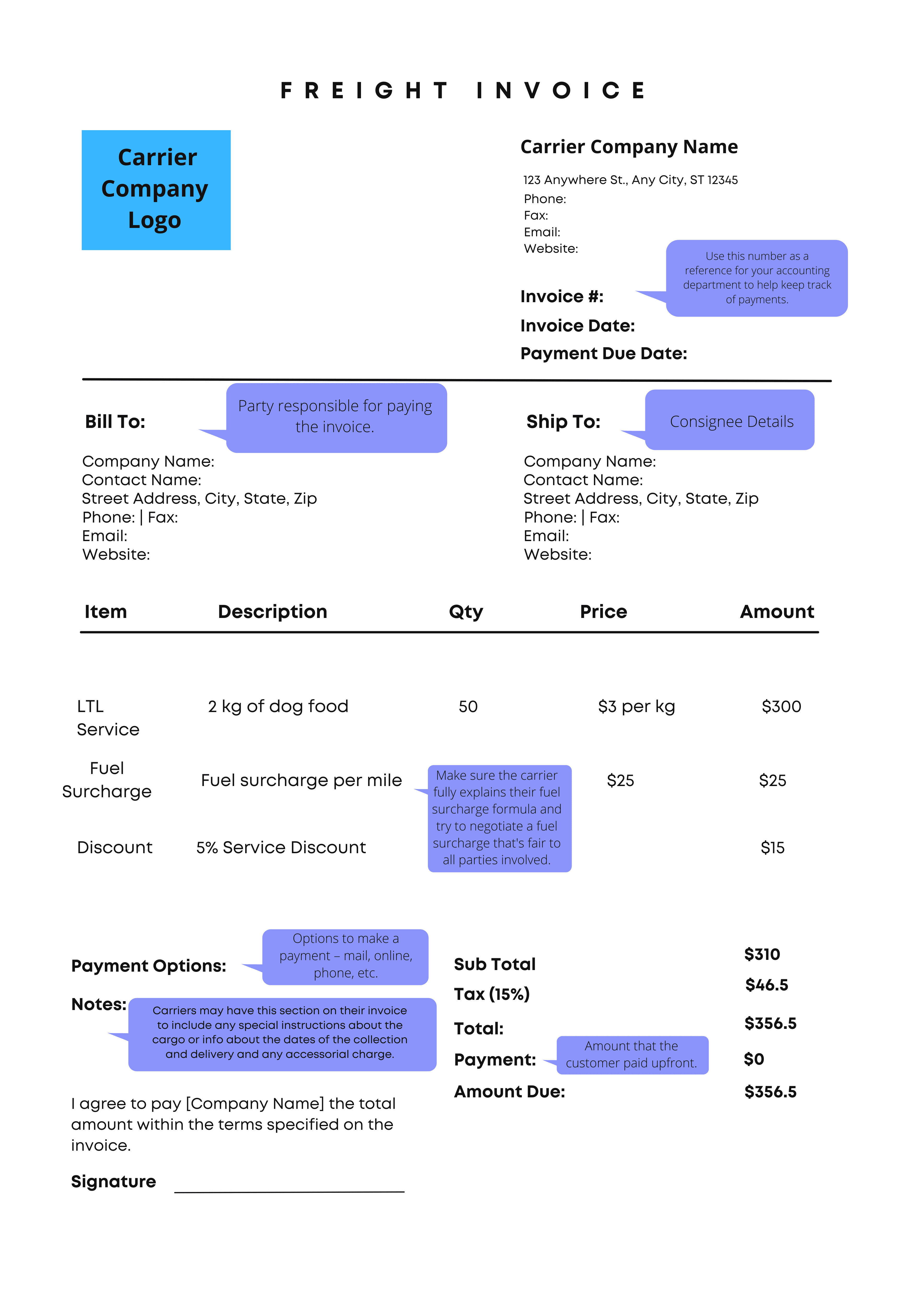
What Is A Bill Of Lading (BoL)?
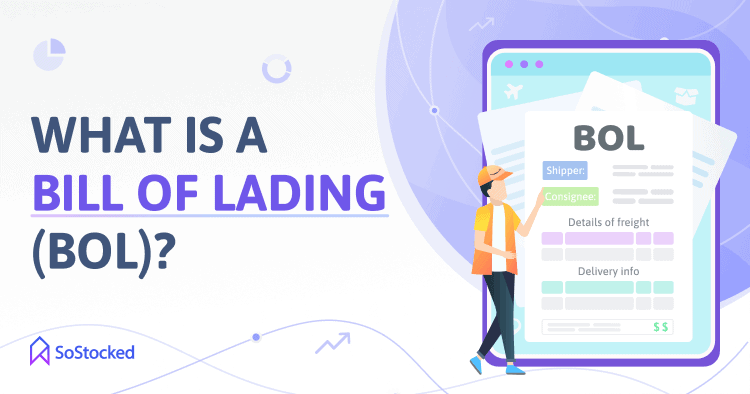
The word “bill” refers to the written or printed statement of the cost for the shipment delivered or to be delivered, while “lade” means to put goods onto a vessel.
The Bill of Lading is a document that describes the shipping arrangement between the main parties involved in transporting a cargo–namely, the shipper, carrier, and consignee. It’s also a legally binding freight contract, so it can also be used as evidence in court in the event of a dispute.
A BoL typically contains:
- Details of freight (e.g., cargo weight and dimensions, pallet count, freight class, and so on)
- Name of shipper (seller of the goods), consignor (owner of goods who assigns a consignee), and consignee (buyer or assigned receiver)
- Type and quantity of goods being transported
- Type of packaging. Are the items going to be put in a carton, crate, pallet, or drum when shipping?
- Payment terms. Freight Prepaid (shipper or consignor is responsible for the shipping fees) or Freight Collect (freight cost is paid by the consignee upon delivery)
- Delivery information of the shipment (when and where it will be delivered)
- Reference numbers or purchase order numbers
- Special instructions. Does your cargo require special handling? Palletize the cartons? Need filler for protection? Need to be refrigerated?
Like freight invoices, the details included in a BoL may also vary depending on the type of BoL used (more on that later).
Because a BoL is a legal document, it can serve as a:
- Formal acknowledgement that all your items have been loaded properly onto the carrier’s vessel. Thus, it helps ensure that the products shipped are the same products that’ll arrive at their final destination.
- Freight contract between the shipper and consignee that lays out in black and white exactly what was done and how expenses were incurred from freight charges to duties and taxes to customs and arrival at the final destination.
- Document of Title. The term “Title” means right to possession of the goods from the carrier. The Document of Title can be transferred by “endorsement” (the shipper puts the name of the buyer as consignee on the BoL) or sending the BoL by courier from one party to the next. Endorsing the BoL means the shipper of the cargo signs the back of the bill and names the party to whom it is transferring the bill.
Master Bill Of Lading Vs. House Bill Of Lading
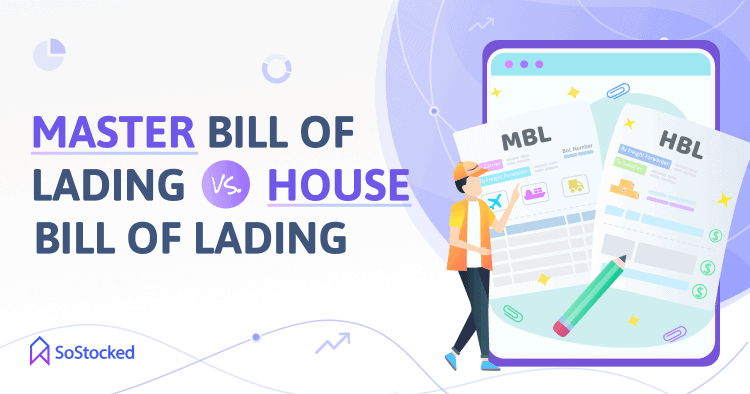
Confusion with these two terms is not uncommon. That is because these two documents are so alike that they are actually near replicas of one another. The only details that will vary are the details on the shipper, consignee, and notify party (any third party to be notified of arrival of shipment).
To best understand the differences between the two, it is first important to understand the difference between a carrier and a freight forwarder. A carrier is the entity that moves goods from origin to destination. A freight forwarder is one who coordinates this activity. So a freight forwarder contracts with the carrier on your behalf to move your goods from point A to point B.
Another difference is who is issuing the document. A Bill of Lading may be issued as a:
- Master BoL (MBL), a document that’s typically issued by the carrier to the freight forwarder. It summarizes the contents of a shipment, including the BoL number assigned and the description of the freight being shipped. It also contains the terms for transporting the freight (ground, sea, or air) and the name and address of the shipper, consignee, and notify party (if any).
- House BoL (HBL), a document created and issued by freight forwarders to suppliers upon receipt of shipment at the port. It acts as a legal document acknowledging receipt of goods.
An HBL includes an HBL number, name and address of the shipper, consignee, and carrier, specific information about the products within the shipment, and the value of the cargo.
In your MBL, the:
- The shipper is the freight forwarder.
- The consignee is the freight forwarder of the cargo’s destination country.
- The notify party may be the same as the consignee or any other party listed in the BoL.
Whereas, in your HBL, the:
- The shipper is the actual shipper (supplier or exporter).
- The consignee is the actual recipient of the cargo (buyer or importer).
- The notify party may be the same as the consignee listed in the bill or any other party listed in the BoL.
Non-Negotiable Vs. Negotiable BoL
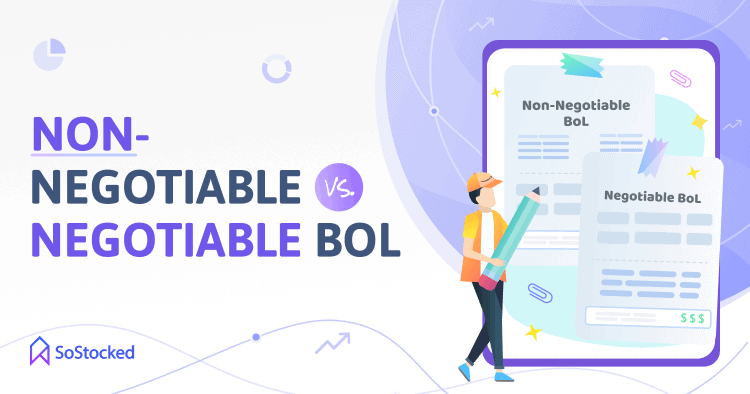
A BoL can either be a non-negotiable or negotiable document.
Also referred to as straight BoL, a non-negotiable BoL is used to set one specific consignee. This means the shipper cannot instruct the freight forwarder to ship the cargo to a company or person other than the consignee specified in the consignee section.
Conversely, under a negotiable BoL, the right to possession of the goods may be transferred from one consignee to the next. Negotiable BoL is commonly used in shipping arrangements where possession of the goods may change hands several times, hence the term “Negotiable.”
2 Types of Negotiable BoL
1. To-Order BoL
A bill of lading becomes a To-Order BoL when it contains “to order” or “to order of [name of the recipient]” in the consignee section. Under this bill, the right to possession of cargo can pass from the original BoL holder (shipper or buyer) to a third party (a bank, for example) by endorsing the bill. Where the term ‘to order’ but no consignee is listed in the consignee section, the bill can be endorsed by the shipper. Conversely, where the term ‘to order’ is added together with the name of a consignee, the BoL can be endorsed by the named consignee.
2. Bearer BoL
The consignee section of a bearer bill can either be left ‘blank’ or stamped with the term “bearer”. Under a bearer BoL, the party who holds the bill has the right to take delivery of the cargo. If the bearer bill is handed over (via courier) to a new party, that new party gains the right to receive the cargo from the carrier. And since the BoL remains with the party with lawful physical possession of the bill, title to the cargo can be transferred multiple times by simply transferring the bill from one party to the next.
Other Types of Bills of Lading
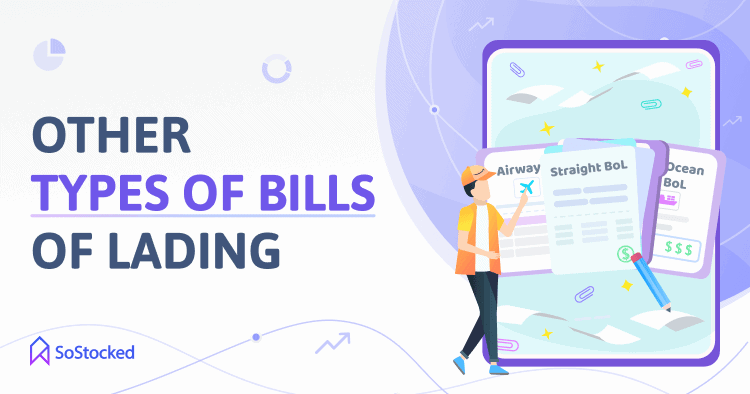
A shipping company may issue a certain type of BoL, depending on how you ship your goods. These include:
Straight BoL
A non-negotiable document that specifies only one consignee and that consignee cannot endorse the BoL to anyone else.
Airway Bill
This is a non-negotiable BoL used to ship cargo by air.
Ocean BoL
This bill is used to ship cargo overseas by sea freight. It can either be a:
- Negotiable BoL, e.g., cargo is consigned directly to the consignee listed in the BoL and no other party.
- Or, a non-negotiable BoL, e.g., the shipper sends the endorsed original BoL to the bank or other party responsible for paying the shipment on behalf of the buyer. The bank holds the original BoL until the transaction is completed, as stated in the letter of credit. A letter of credit is a document sent from a bank that guarantees that a seller (shipper) will receive the buyer’s payment on time and in full amount. Once all of these things are fulfilled, the bank may now endorse the buyer as consignee of the original BoL.
Inland BoL
This is usually, though not always, a non-negotiable bill used by shippers and carriers to domestically transport shipments by ground freight, such as by truck or railroad. Either the carrier or shipper can create this BoL. Once finalized, it enables the carrier (e.g., trucking company) to pick up shipments from a factory to an international port. This document can also be used in combination with Ocean BoL.
Multimodal BoL
Carriers use this document when shipping goods via two or more modes of transport.
For instance, moving cargo between Shanghai to Los Angeles under multimodal transportation. After your cargo is loaded into a container, the shipping company sends their trucker to pick up the container in Shanghai. The trucker then delivers it to the Shanghai Port. Once the cargo arrives at LA port, it is again transported to the final destination by the trucker that works under that same carrier. So, even though multimodal BoL includes various modes of transport to move cargo, it still falls under one single BoL. This means the carrier is responsible for the cargo from the place of receipt to the place of delivery.
As you can see, it works like your typical Ocean BoL, except it eliminates the need to create a separate BoL for inland transportation of your cargo, i.e., from the shipper’s location to the origin port or destination port to final destination.
How To Read A Bill Of Lading
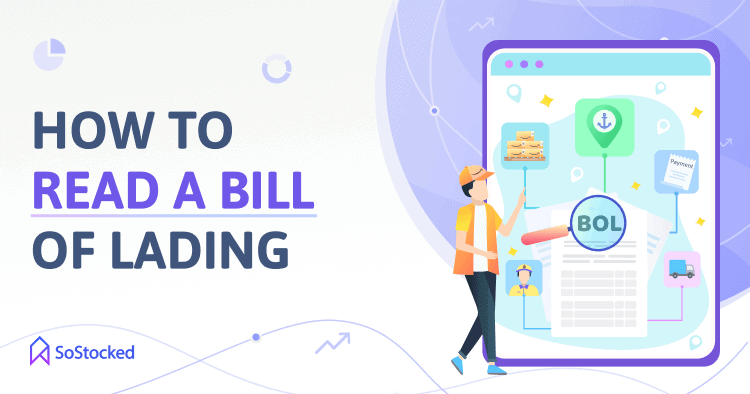
Carriers and freight forwarders alike have their own BoL template or format. You’ve probably been given a bill of lading where different aspects are listed differently than the ones you’ve had before. So, it’s easy to get confused when you’re trying to understand a BoL you’re not familiar with.
Below is a quick guide to reading your Bill of Lading.
1. Distinguish the Differences Between the Main Parties Involved
There are five main parties involved in sea freight, and each has different responsibilities.
Carrier
As mentioned earlier, it’s the party responsible for moving your goods internationally and/or domestically.
Shipper
The supplier or exporter of your inventory order.
Consignee
The receiver and generally the owner of the inventory being transported.
Ultimate Consignee
The ultimate consignee is the person or entity who will be the final recipient of the shipped goods. Often, the consignee is the same person as the ultimate consignee. Suppose you’re shipping your inventory to a 3PL warehouse or direct to an Amazon fulfillment center. In that case, your business will be named as the ultimate consignee because ownership of the goods will be transferred to you when that cargo is delivered. If you’re sending to Amazon, use the fulfillment center Amazon has assigned to your shipping plan as the business address of the consignee on your BoL.
Additionally, if a bank is responsible for paying the freight charges on behalf of the recipient, the bank becomes the rightful consignee (not the actual recipient), and that detail should be listed out in the instruction section of the BoL.
Notify party
The notify party is the person who should be contacted on or before the scheduled arrival date of the cargo. It could either be a third-party entity (a bank if cargo is used as collateral) or a customs agent/freight forwarder assigned to help facilitate getting the shipment through customs and to its consignee. In this case, the consignee may choose to put the customs agent’s details in the Notify Party section.
2. Understand the most critical details on a BoL
On your bill of lading, five of the most essential details are:
Carrier information
The carrier section outlines the company responsible for moving the goods from the supplier to the recipient. It can include the carrier name, address, and contact information.
Shipper Details
The shipper section typically includes the shipper’s name, address, and contact information. You may find other details, such as the supplier or shipper’s contact representative and the company’s registration number.
Consignee Details
This section details the place where the goods will be delivered when the shipment arrives at the country destination. As such, it includes the receiver’s name, address, and phone number.
Cargo Details
In this section, you’ll find the most important aspects of your bill of lading. It describes your shipment in detail, including the product name, freight type (dangerous, perishable, oversized, etc.), package dimensions, weight, quantity, freight class (more on that in a bit), and how the goods are loaded (floor loaded or palletized).
Port of Loading and Port of Discharge/Unloading
As the term implies, port of loading refers to the place where your goods are loaded into a vessel to be transported to its country of destination and upon arrival, are unloaded at the port of discharge (unloading). The goods are, thereafter, shipped to their consignee(s). But instead of a typical address, the port of loading and discharge is indicated with five letters. For example, in ocean BoL, shipments coming from the Los Angeles port would have “USLAX” on the port of loading and discharge section, where US refers to the country of origin, while LAX denotes LA port.
Note: Some BoL templates may also have a section where other pieces of information about the cargo are specified, such as Shipped On Board Date (the date on which the goods were loaded on board the vessel), shipper’s special handling requirements, or HTS codes for specific customs clearance needs on the recipient’s side (more on that later).
3. Familiarize yourself with the other important details
The other essential BoL details you should know are:
Bill of Lading Reference Number
This number is generated to help the shipper, consignee, freight forwarder, and the notify party to identify and track the cargo during transportation.
Payment Terms
How are you going to pay for your load? Freight Prepaid or Freight Collect? These terms imply who should be responsible for paying the freight cost. Freight Prepaid means the shipper pays the freight, while Freight Collect (or Cash on Delivery) means the consignee pays the shipping fee.
General Terms and Conditions
This section defines the shipping company’s limited liabilities (what damage or loss of goods they are liable for when the goods are in their possession as carriers) and the total amount (declared value of cargo) they are liable for. Unfortunately, carriers will often incorporate the Carrier of Goods by Sea Act (COGSA) into their bills of lading. And one of the controversial provisions of this act is its $500 per-package limitation. Under COGSA, if your package is destroyed or lost due to negligence or intentional misconduct, the carrier may be allowed to limit their liability to $500 only. Imagine losing $15,000 worth of package and only get repaid for it with $500! Fortunately, US courts have created 2 preconditions before carriers can essentially keep their liability as low as $500 under COGSA.
- The carrier must provide their customers with “Adequate Notice” of the $500 limitation by explicitly incorporating the terms or provisions of COGSA into their shipping contracts.
- The carrier must give their customers a “Fair Opportunity” to avoid the $500 per-package limitation by increasing their cargo’s declared value. For a fee, customers will have the option to declare a higher excess value to increase the amount their carriers would pay them in case of cargo damage or loss. If you want a more comprehensive coverage for your cargo, consider getting an all-risk cargo insurance. It covers the full value of your shipment while en route to its destination.
Freight class (LTL)
A freight class is a standardized pricing classification system for goods transported through Less than Truckload (LTL) freight. This system has 18 classifications that are determined by the National Motor Freight Traffic Association (NMFTA) and made available through the National Motor Freight Classification (NMFC). Freight classifications can be based on the shipment’s:
- Density or dimensions. Density measures how heavy a package is relative to its size. As the density of your package increases, the LTL freight class lowers (or vice versa), leading to cheaper shipping costs.
- Stowability (the more difficult to load, the more expensive your shipping fees are going to be)
- Handling (fragile or bulky goods that require special handling cost more)
- Liability (probability that the goods may be broken, stolen, damaged, or cause damage to other items nearby)
If your package doesn’t have major stowing, liability, and handling issues, the LTL carrier may use density as the main factor for its freight class.
Carriers determine a package’s density-based freight class by:
1. Finding its total cubic inches
Length in x Width in x Height in = Total Cubic Inches
2. Finding its cubic feet
Total Cubic Inches ÷ 1,728 = Cubic Feet (1,728 is the number of cubic inches in a cubic foot.)
3. Finding its pounds per cubic foot (PCF), i.e., density
Package weight (lbs) ÷ Total cubic feet = PCF or Density
Note: When weighing your package, make sure to include the pallet or other packaging as part of your calculation.
Quick sample:
- Let’s say you’re shipping a compact air fryer in a 12″ x 12″ x 18″ box.
- The weight of the air fryer is 5.7 lbs + 1 lb packaging weight = 6.7 lbs total weight
- Packaging dimensions: 12″ x 12″ x 18″ = 2,592 cubic in
- 2,592 cubic in ÷ 1728 = 1.5 cubic ft
- 6.7 lbs ÷ 1.5 cubic ft = 4.5 PCF/density
- The recommended freight class for our example according to the freight class reference charts is 175.
Freight class can make a huge difference in determining your freight cost. For instance, a package that would cost $15 in class 50, could double to $30 in class 175, and probably go up to $160 in class 500.
Products with higher freight classes are usually more expensive to ship due to the amount of space they take up (e.g., oversized packages occupy extra space that could’ve been used for other shipments). Issues in handling, stowability, or liability also increase costs. For example, bags of gold dust usually have the highest freight class of 500 due to the high risk of theft (i.e., a huge liability) even though they seem lightweight.
But if your package doesn’t have those handling or liability issues, adjusting its weight is usually the fastest way to lower cost, as getting into a smaller density range will change your freight class. Remember, heavier weight freight classes cost less per pound. So, ship in bulk to get a weight break (or discount) and to find your way into a lower freight class range. Lastly, talk to your 3PL about optimal ways to organize your boxes or pallets.
Bill Of Lading Sample
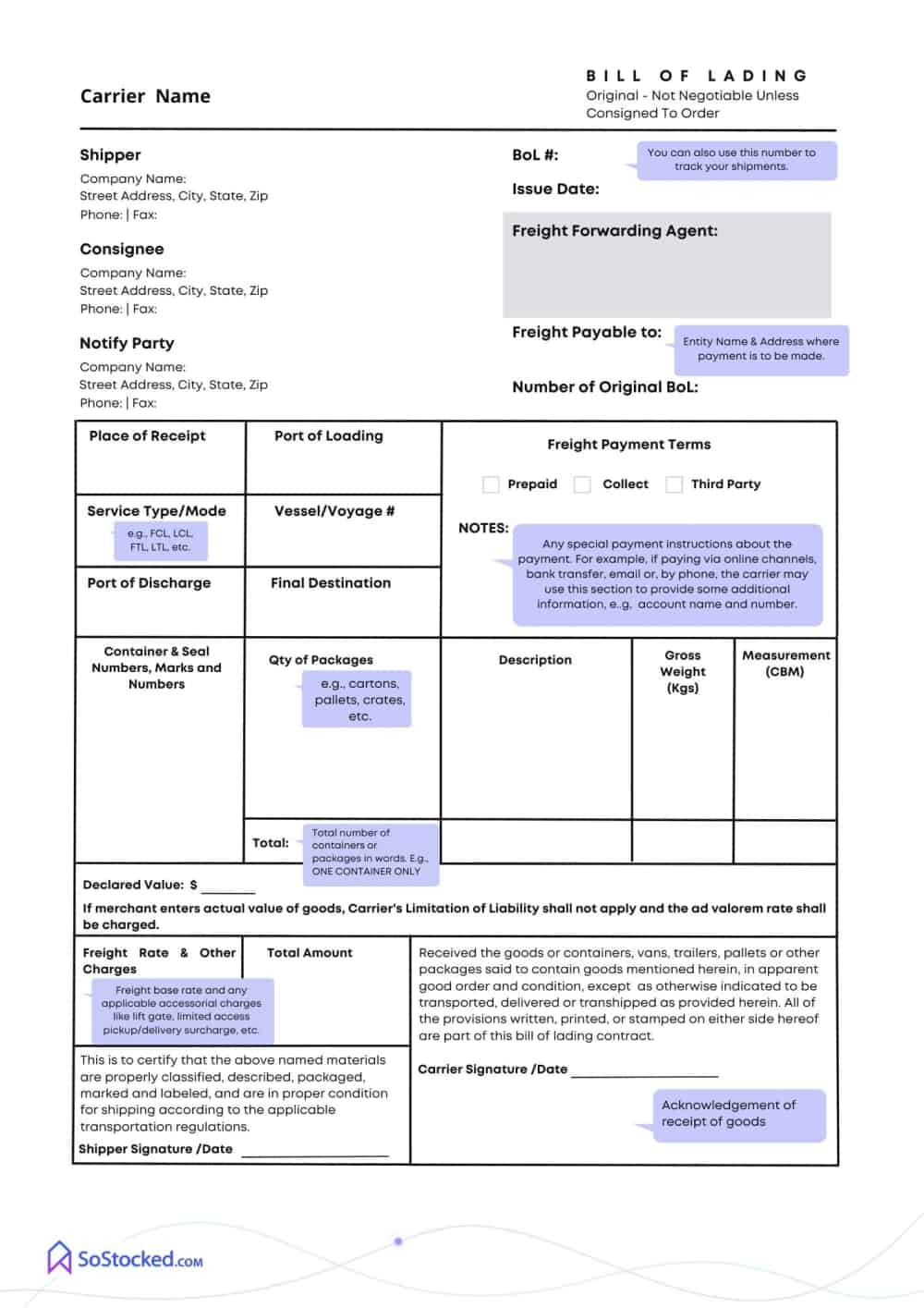
Differences Between Freight Invoice And Bill Of Lading
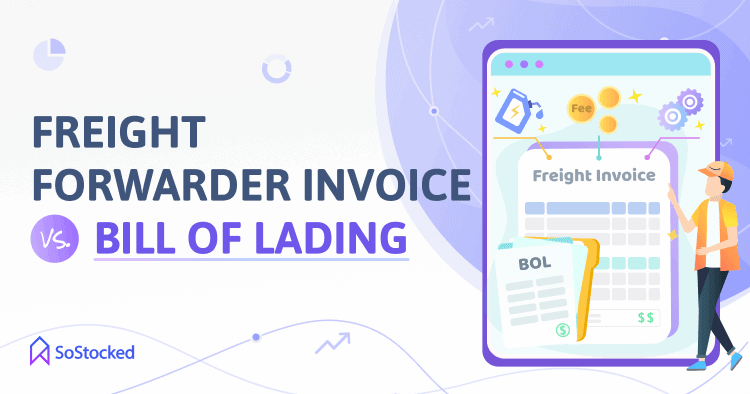
While freight invoices and Bills of Lading share some similarities, they also have distinct differences that help provide a fuller picture of your shipping arrangement with your freight forwarder.
Freight invoices offer a detailed description of all the fees associated with shipping your cargo from country of origin to country of destination. Specific charges are set forth on a freight invoice, but are not found in a BoL. These include freight, fuel, ancillary fees (admin and documentation), and accessorial fees (charges for services beyond the standard pickup and delivery). I will go into more detail about accessorial fees soon, but just to give you an idea about those extra services that require accessorial fees, here are some of them: lift gate, residential delivery, inside pick up or inside delivery, oversized shipment, cash on delivery service, reweigh and reclassification, and fuel surcharge.
In contrast, bills of lading are legal documents that describe the carriage contract between the carrier and shipper. A BoL specifies things like what kind of item is being moved, when and where is it being picked up, where is it going, what does it look like, how much does it weigh, and so on.
When freight invoices and bills of lading are used in conjunction, these documents give you a more accurate cost of your shipment. In a freight audit (checking the accuracy of your invoices), you can use both documents to find mismatches between your freight bill and BoL so that in the event you do find inaccuracies, you can easily make a claim and resolve the issue with your FF.
Shipping Fees That Impact Freight Costs
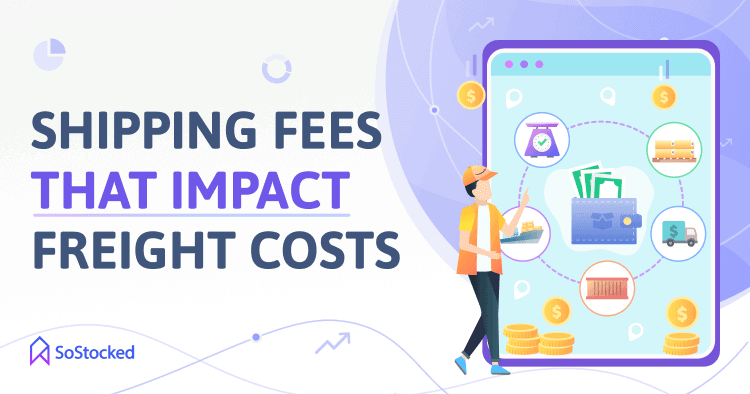
Cargo Type
Carriers transport several types of cargo through the supply chain. Each type requires different handling needs to ensure they arrive at the port in good condition, which makes one type more expensive to ship than another.
For example, dangerous (flammable products), oversized, hazmat, fragile, and perishable goods require a unique vessel, container, and handling. So, shipping any of these items will likely cost you more. Foodstuff is especially challenging to handle and transport because of its short shelf life and high chances of spoilage.
For this reason, perishable goods are often transported by air. If by sea, they’d have to be stored in refrigerated cargo ships called reefer vessels. These ships are equipped with temperature control units to keep the containers cool all the time, which helps preserve the food’s lifespan and prevents bacterial growth.
Importing products like prescription drugs, medical devices, and cosmetics will also cost more, as they usually come with FDA registration fees.
Overall, knowing your cargo type will help you plan for any potential additional charges, ensuring you build them into your expenses when calculating your profit margins.
Weight and Volume
Your cargo’s billable weight is greater of either the actual weight or dimensional weight. Let me explain.
When you put a box on a weighing scale, you get the actual weight of that box regardless of its packaging shape and size. But most freight forwarders implement a cost structure based on dimensional weight, a package’s volumetric weight based on its length, width, and height. Why?
Long-haul trailer trucks and cargo planes often have large spaces that are under-used when people are shipping small packages. For instance, you might put a heavy but small, fragile product in a big box and surround it with a protective filler to keep it whole and safe during transport. That’s an excellent way to pack it. But the big package also occupies a lot of room that the carrier could use for other products. Therefore, they would charge you extra for that. Yes, in part, you will be charged based on how much space your cargo takes up.
And because dimensional weight offers a more accurate representation of a package’s weight and volume, many carriers use it when determining the billable weight.
Conversely, some companies may use the package’s actual weight when it’s greater than the dimensional weight. That’s because they cannot fill a container when smaller but heavier items prevent them from loading more packages when the vessel’s max weight capacity is reached.
Talk to your supplier to determine your cargo’s actual and dimensional weight to get an accurate freight quote. To save on shipping costs, discuss package optimization techniques to find the right packaging materials for your cargo type, e.g., tightly packing small items in a carton. Not only will this improve packaging efficiency, but it also aids in protection of your shipment during transport.
Packing and Palletization
It is important to maximize the efficiency of your shipping operations to keep costs low. So, the packages should be loaded on the vessel or container through optimized means, i.e., palletization or tightly packed units in a carton.
To optimize space, floor loading is the best option as you can fit more units into a container this way. However, some 3PL managers are advising that palletization might be a good choice if there is trouble with your cartons arriving damaged. Recently, as of this writing, some 3PLs have found that the cardboard of the cartons coming out of China is very thin due to a cardboard shortage coupled with products being loaded in a haphazard way and much damage is occurring in transit. To solve this problem, some sellers have resorted to palletizing their containers to protect against damage.
While palletizing means less cartons per container, a mathematical exercise could be done to assess which loss is more costly–the damages upon arrival or the lost space and smaller shipment size. If damaged goods is an issue you are facing, it may be worth a conversation with your 3PL manager, supplier and freight forwarder.
It’s also important to note that there are certain Amazon pallet requirements that carriers need to follow to ensure your cargo will be received by your FBA warehouse without any problems. So make sure that the freight forwarder you’re working with understands these special requirements.
For example, your supplier may stack your pallets higher than Amazon’s requirements in order to maximize space within your container. Therefore, if you are loading pallets that are higher than Amazon’s requirements, you will have to stop first at a 3PL warehouse to re-palletize your shipment to meet Amazon’s pallet specifications before delivery.
In that case, expect and plan for pallet breakage (breaking apart your pallet) and re-palletizing fees. Discuss this in detail with your 3PL to ensure you understand all applicable fees and factor them into your expenses.
Related: 14 Mistakes Sellers Make When Shipping to Amazon FBA
Ocean Container Rates
Sea freight containers typically come in two sizes: 20ft and 40ft containers. Your container rate depends on whether you need a:
Full container load (FCL)
In FCL freight, you are leasing the whole container and are charged at full price. Data from Freightos’s Global Container Freight Index shows that the cost of shipping per 40ft container has increased from $2,000 (January 2020) to a little over $9,000 (as of November 2021).
For many sellers over the past 2 years freight expenses have gotten very costly, making cost-cutting solutions an extremely important part of supply chain strategy. Suppose your Chinese supplier only produced enough inventory to fill a 20ft container this week, but the cost of shipping a 20ft container from Asia is approximately 90% of the cost of a 40ft container. In that case, it might be a good idea to explore your LCL options before leasing a 20ft container. If you’re also worried about stocking out, perhaps ship a portion of your finished inventory via LCL and keep the rest in your supplier’s warehouse. Once they’ve manufactured enough stock to fill a 40ft container, then use FCL. Talk to your freight forwarder about your LCL options to ensure you have the best deals possible.
Less than container load (LCL)
You share the container with other customers. Thus, you’re only charged for the space your cargo takes up. LCL rate is calculated based on volumetric weight or actual weight, whichever is greater, this is your billable or chargeable weight, as explained above. Therefore, your shipment gets more expensive the heavier your load is and the more space it takes up. Goes without saying, consider LCL if; one, you’re shipping lightweight cargo, and two, if your cargo isn’t enough to fill a full 40ft container.
Both FCL and LCL rates vary depending on the shipping route, type of cargo, seasonality, and handling requirements like the following:
- Heavy Lift Surcharge. Fees for lifting heavy FCLs typically show up on your freight invoice as “Heavy Lift Surcharge.” Your carrier might need to use a crane or other specialized equipment to lift heavy shipments. The extra fee helps cover that cost.
- Out of Gauge (OOG). This term refers to shipments that are too tall or too large for a regular six-sided container, hence “Out of Gauge.” Some examples are car trailers, parts of wind turbines, construction machinery or equipment, and luxury coaches. OOG can be a costly affair because carriers need to use specialized heavy-duty equipment to handle such massive cargo for transport by ocean. Plus, these items also eat into space that carriers could have been used for other shipments, so they will also charge additional fees to make up for this wasted space. Fastening them securely will also require additional materials or straps, which means added cost.
Make sure you’re being charged the correct amount by checking your carrier’s updated additional handling surcharges. For instance, Hapag-Lloyd now charges a heavy lift fee for the following:
- $750 for a 20ft container weighing more than 23 tons and coming from Middle East Region to West Africa
- $1,250 for a 20ft container weighing more than 23 tons and coming from Middle East Region to South Africa
Knowing your freight forwarder’s surcharges can help you to plan ahead of time to avoid such fees wherever possible by building out your containers to fit the proper specs required by your carriers.
Pro tip: Sea freight is considered the cheapest for shipping goods internationally. But it usually takes a month for ships to arrive. Not to mention, during busy times like we face this Q4, there is often a delay in securing passage for your cargo due to container shortages, and backlogs in unloading at destination ports can cause further delays. So, if the lead time is too long, and you want to avoid stocking out during peak season, consider holding back some units at your supplier and air shipping them if needed to ensure you stay in stock while waiting for your sea cargo checks in. In SoStocked, you can calculate how much stock to ship by air express and by standard freight to prepare for such emergencies.
Drayage Fees
The root word “dray” refers to a vehicle used to move cargo, specifically a horse-drawn carriage or wagon in the olden times. But in today’s terms, drayage means transporting shipments over short distances to either prepare them for the next phase of the journey (3PL warehouse for repackaging) or delivery to their final destination (FBA).
So if you see “drayage fees” on your freight invoice, this fee covers the cost associated with moving your cargo from the port of discharge to its next destination (3PL warehouse or FBA) or from one warehouse/prep center to another.
Main factors that affect drayage cost are:
1. Distance Traveled
The distance between the place of origin and final destination. Sending your cargo further away is generally more expensive than shipping it to a nearby location.
2. Chassis Split Fee
A container chassis is used to facilitate inland transportation from the port of destination to the consignee. You may incur a chassis split fee if your container isn’t located in the same place as the chassis. In this case, your carrier will charge you a chassis split fee to compensate for the cost of transporting the chassis to your container’s location.
3. Pre-Pull Fees
A pre-pull fee occurs when a trucking carrier picks up your container from the port and stores it at their yard to help avoid demurrage fees (more info below) when it can’t be delivered to its final destination immediately. You may also see “pre-pull fee” under an “origin or destination charge” on your freight invoice.
4. Drop Fees
You may be charged a drop fee by your trucking carrier if they have to drive back to your warehouse to pick up the trailer after it’s been unloaded rather than unloading immediately and leaving with their trailer in the same trip. Sometimes truckers can’t unload trailers quickly (due to congestion at the dock or if unloading the cargo needs special equipment), so they just drop off their trailers and leave. Before transporting your goods domestically, find out whether your trucker will charge a flat rate or twice the freight rate for a drop (twice because they have to drive back the next day or later). If you regularly ship high-volume goods with them, be sure to negotiate for a lower drop rate. Also, some truckers will not charge any drop fee at all as long as your cargo’s final destination is within their predetermined drop zone (usually within a few miles of the port). So, it’s really important to talk to your carrier about drop fees to keep drayage costs low. Getting your 3PL manager looped into this conversation can be important as it is the warehouse’s organization or lack thereof that can cause you to incur such fees.
Documentation Fees
A documentation fee is usually required by carriers or freight forwarders to prepare or handle your cargo’s origin and destination requirements.
Documentation fees currently range between $50 and $100 per bill of lading. But this rate increases depending on carriers/FFs, volume of documentation, and complexity of documentation.
For instance, manual booking transactions like through emails or phone calls instead of using your carrier’s website or 3rd-party software may cost you more. Manual booking is simply more time-consuming because the admin staff needs to spend extra time on manually inputting your booking information into the company software and maybe even go through their email to find your records. As such, you’re likely to pay a higher documentation fee per bill of lading.
Aside from bill of lading, carriers, FFs, or shippers may also charge additional fees for preparing and handling the following documents:
Shipping Quote
A document that shows a carrier’s estimated cost of shipping a particular cargo from the point of origin to the final destination.
Freight Invoice
A document that summarizes the shipping fees that you have to pay upon receipt of your cargo.
Certificate of Origin
A document that confirms that items in your shipment were obtained, produced, and processed in the country of origin.
Material Safety Data Sheet
A technical document that describes the potential hazards of a dangerous product and instructs ways to work with it safely.
Shipper’s Letter of Instruction
A document that contains the shipper’s instructions to the freight forwarder. It primarily contains information on how a shipper would like a shipment to be handled and delivered to the consignee.
Booking Confirmation
A document issued by the freight forwarder to the shipper confirming the shipment details submitted and booking of the requested 3vessel and container space.
Packing List
This document describes the packaging details of your cargo, including the weight and dimensions of each package and important marks and numbers displayed on the boxes.
Commercial Invoice
A document that a supplier provides to indicate the value of the goods being shipped. This value, along with HTS codes, is what is used to calculate duties and taxes.
Letter of Credit
A legal document from a bank guaranteeing that the shipper will receive their payment on time and in the correct amount.
Pro tip: Be sure to ask your service provider about the types of documents that are included in their documentation fee to know precisely what you’re paying for.
Demurrage Fees
Demurrage refers to the fees applied to shipments that are not unloaded or transported out of the destination port within the port’s allotted time (usually 4 to 7 days, though each port or terminal varies). Generally speaking, the shipper pays the demurrage charges. But the consignee may also be required to pay if they caused the delay or they’re contractually obligated to pay the fees, as per contract terms and conditions.
Additional Fees
In some cases, your carrier may charge you extra for going beyond the regular pick up and delivery service they do. Below are some examples of extra services that come with additional fees.
Surcharges
Surcharges are simply additional fees for services that include delivering packages to less accessible areas (Delivery Area Surcharge), shipping oversized items (Large Package Surcharge), and so on.
Additional Handling Fee
An extra fee is charged for shipments that require special handling.
Address Correction
An address correction fee may be issued to people who want to change the initial ship-to-deliver address while the package is in transit. This fee would be charged to cover the additional admin and logistics needed to divert the shipment to the new destination.
Chargeback for Consignee Billing Shipments
According to UPS, a refusal fee per shipment on top of the original shipping fees may be charged to the shipper in the event of non-payment, insolvency, bankruptcy, or refusal to pay by the consignee.
Bulky or oddly shaped packages
A fee for items that are difficult to stow and handle due to their irregular shape.
Freight Audit Checklist
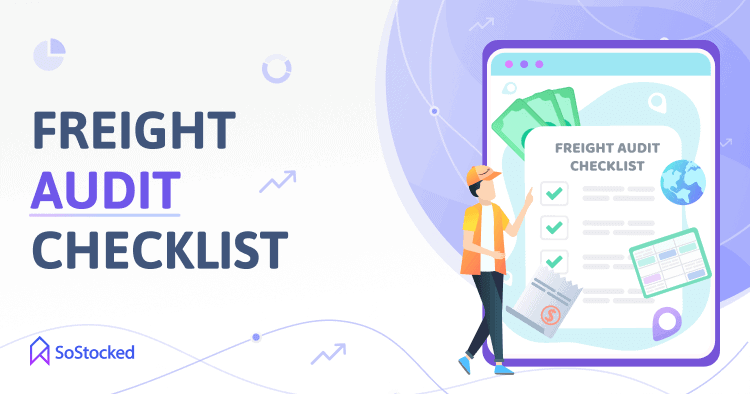
Now that you understand the fees displayed on your freight invoice and bill of lading, it’s time to learn how to spot potential errors in them so they won’t go unnoticed for too long.
Called a freight audit, this process involves verifying freight invoices to find and resolve dubious charges immediately. Are your invoices accurate? Does the actual cost charged match the quoted price?
Inaccurate freight invoices are actually more common than many people realize. A report from ControlPay reveals that only 17% of all freight invoices are accurate. But those inaccuracies aren’t necessarily due to unethical practices by your freight forwarder. In some cases, mistakes happen when there’s miscommunication.
Maybe you negotiated a price of $5,000 for a 20ft container, but the freight forwarder charged you $6,500. They probably failed to communicate a sudden price increase that could be due to fuel price hikes, seasonality (busy time of year), additional services needed, etc. That’s why you need a freight audit process to find and confirm these fees before they lead to unnecessary overspending issues.
So to set your company up for success, follow this freight audit checklist.
Collect and Upload All Freight Invoices
Put all your invoice data into a single spreadsheet, bookkeeping software, or any electronic system. This way, you avoid having to go back and forth to your email to piece various invoices together during an audit process or while doing landed cost calculation and inventory valuation. Streamlining your data allows you to pull up any freight invoice you need quickly.
Categorize Invoices
Group your invoices by freight forwarder and within each group, sort the invoices by date (from oldest to newest). This method makes analyzing specific invoices from specific carriers easier. You’ll also be able to compare old and new freight forwarder fees and see how much they have increased over time; are they regular increases due to inflation, or is something off?
If something is off, for instance, a huge price jump in the last four weeks that couldn’t possibly be explained by inflation, ask your freight forwarder for an explanation and resolve the issue amicably.
Verify the Charges on Your Invoices
Combing through the information in an invoice or BoL to find potential errors is often considered the long and difficult part of any freight audit process. Here’s how you should go about it.
Accessorial Fees
Surprised to see some additional charges on your bill? The thing is, accessorial fees are hard to predict because mistakes are unpredictable. That’s why add-on fees often come in the form of:
Demurrage Fees
As mentioned earlier, it’s a fee that comes with unloading containers and returning them beyond the deadline given by the port authority.
Lift Gate Service
Not all consignees have a loading dock, so truckers equip some of their trucks with a platform that allows them to raise or lower a shipment from the floor to the truck, hence “Lift Gate.” However, this additional investment means additional cost for truckers. Therefore, if unloading or loading your shipment requires this service, it will be listed out as such on your invoice.
Inside Pick Up or Inside Delivery
This fee covers the extra time and effort it takes to pick up or deliver a shipment beyond the front door or loading dock.
Limited Access Pickup or Delivery
Picking up or delivering shipments to less accessible locations like prisons, schools, or military bases normally come with additional costs that carriers pass on to their customers.
Collect On Delivery (COD)
If the carrier is responsible for collecting the payment for the cargo being shipped, they may charge a fee for the additional paperwork required for this kind of shipping arrangement.
Advance Notification
A fee for notifying the consignee before making a delivery.
Reweigh and Reclassification
If the carrier inspects a shipment and the weight and its corresponding freight classification does not match, they will charge a fee to reweigh and reclassify it along with the difference.
But these mistakes may not be your fault at all. So, it’s crucial to verify you’re not being charged wrongly for these add-on services or for any service that was already waived or reduced in your contract. Additionally, plan your shipping needs in advance to help you to avoid incurring these fees.
Base Rate
Factors that determine a shipment’s base rate (gross price before discounts or promos) typically include:
- Mode of transport (sea, air, or ground)
- Density or weight
- Freight class
If you or your supplier provided your carrier with incorrect cargo weight information, you could end up with overpaying or underpaying. Plus, reweighing and reclassifying your cargo will likely also cost you additional fees, not to mention time. Either way, you don’t want that hassle. So, it’s essential to ensure that the base rate specified on your bill is correct.
Discounts
Verify that any expected or discussed discount or promo has been properly applied to your freight invoice.
Late Delivery
Depending on contract terms and conditions, carriers and shippers may be subject to penalties (5% of the total value of the goods shipped) if they fail to deliver the cargo at the agreed time. In some cases, the 5% penalty only applies if the delay is more than 7 to 12 days. The point is, you can use the Late Delivery and Penalty clause in the contract to recover the money owed to you or ask for lower rates.
Taxes
Confirm that the invoice reflects the taxes applied are consistent with current tax laws, customs fees, and international tariffs. As part of this, ensure that the correct HTS code was applied. This should always be double checked before shipping but if any error is made afterwards and you have explicit instructions giving the correct HTS, you may be able to recover the difference if overcharged on taxes due to FF errors.
Total Amount
Finally, verify the total freight charges after reviewing all other additional fees and possible reductions to your invoice.
Recognize Duplicate Charges
Duplicate charges can happen for various reasons, such as:
- When bad actors take advantage of you
- When carriers make the mistake of counting one shipment as multiple shipments
- When your FF or carrier makes the mistake of generating an invoice for the same cargo twice
To recognize duplicate charges, go through your accounts payable documents and look for invoices with identical or closely matching invoice numbers and dollar amounts. Confirm these duplicate charges with your carrier so you can get reimbursed.
Know When You’re Being Overcharged
Have you ever been charged more than the agreed upon price? Perhaps you were quoted $4.5 per kilogram for your shipment of dog treats, but your carrier charged you $4.75 by mistake. Or, the cargo weighs 300 kg, but the invoice shows you were charged for 325 kg.
Errors can easily sneak in during transactions like this because there are many factors to consider when determining your freight charge. But these discrepancies, however small, can snowball into huge losses if not addressed immediately.
Avoid being overcharged by checking whether or not:
- The correct rate has been applied. Did your cargo qualify for a bulk rate offer, but the carrier did not apply it to your invoice? In shipping, importers can look into their shipment’s weight break–the weight or unit quantity at which a cargo becomes eligible for some bulk rate–to reduce their freight cost.
Another thing to look at is the rate that your carrier applied to your selected shipping service, e.g., Express or Standard. Make sure the rate given matches the current industry rate for these services. Check out this 2021 guide to UPS, DHL, and FedEx rate increases and surcharges for more information. You can also, of course, review the container rate index when shipping overseas. - Any surcharges were applied that account for any discrepancies and whether they are valid.
- The correct volumetric weight calculation or container size (20ft or 40ft) was applied.
- The correct shipping zone is assigned to your LTL/FTL destination postcode. Shipping zones are geographical locations to which ground freight carriers deliver. It’s defined by a group of regions or zip codes that typically have the same shipping rates. The zone nearest to a package’s point of origin is called Zone 1 (the least expensive), while the furthest zone is Zone 8 (the most expensive). The point is, a different shipping zone assigned to your cargo’s destination postcode can impact your freight cost.
Contest Overcharges
On your Excel spreadsheet, add a “Reconciliation” sheet and create a column for “Name of Freight Forwarder”, “Invoice Number”, “Overcharge Amount”, and “Reasons for the Overcharge Amount.” Lastly, put an auto-sum at the bottom of the sheet.
Possible reasons for overcharges are:
- Incorrect rate per kg or lb
- Wrong shipping zone; should be Zone 1, not Zone 2
- No surcharge applicable, e.g., remote area surcharge or large package surcharge. Note that rates may vary per carrier and you should check this per carrier. For example, if you’re using UPS, a large package surcharge is usually applied to domestic shipments if the length of the box and the girth [(width x 2) + (height x 2)] reach more than 130 to 165 inches.
This is not an exhaustive list and more reasons may be identified. Make sure to update this report every week, as needed, and reconcile the overcharges with your carrier as soon as possible. Try calling your Account Manager at your freight forwarder’s office to assist you with liaising with their Accounting Department to start processing your claim for reimbursement. If the amount is considerable, the freight forwarder might try to pay back the overcharges by offering discounts on your future invoices until paid off or pay you back in full on your next order.
Lookup Your HTS Code to Ensure it’s Correct
HTS stands for Harmonized Tariff Schedule, a commodity classification and coding system that’s used to classify and define international goods so that customs authorities can impose the correct tax duties. This system is developed by the World Customs Organization (WCO), an organization that “promotes certainty, predictability and security of the international movement of goods and people accompanying goods by establishing clear and precise standards.”
When shipping to Amazon, the supplier or freight forwarder will assign an HTS code to each product within a shipment, which must reflect the correct HTS code of the importing country.
In the US, the HTS code is a 10-digit code. The first six digits are derived from the HS codes, or Harmonized System (codes that define/classify the imported goods), while the last four digits are given by the US International Trade Commission to provide additional classification.
The assigned HTS code helps the proper authorities of the importing country determine the correct duty rate, tariff reduction, or additional duties for a product. If you’re using an incorrect HTS code, however, it may result in overpayment/underpayment of duties, penalties, border delays, or an unexpected customs audit.
You could potentially save a lot of money on your import fees by investigating how your products are being HTS coded. It could potentially take time and may require the assistance of a trained professional who knows customs law well, but if you find a legal code that really saves you money, it can make a massive difference to your business. It is important to note that this is a legal decision and working with a trained pro may be the best option. Think of HTS codes like the U.S. tax code. There may be multiple legal ways to classify your expenses but you want to use the classification that saves you the most on taxes and you want to be sure it is a legal classification.
Why is it sometimes difficult to find the right HTS code?
Multiple codes may be suitable for a single product. Try looking up the HTS code for, let’s say, “kitchen paring knives” through the US HTS website, and you’ll get so many codes it’s impossible for an untrained person to identify which one is best for cost-saving purposes.
The complexity in finding the correct code for your products makes teaming up with the right product sourcing expert all the more critical. And I don’t just mean your Chinese supplier who probably doesn’t understand the US Tariff Codes System because it’s written in English. Or your freight forwarder who isn’t exactly trained in the intricacies of this. But a real expert. Someone familiar with import/export, HS and HTS codes and the subtleties of this side of sourcing and importing.
Within our own business, we worked with Afolabi Oyerokun of Honu Worldwide, who has been in this line of work for over two decades. When we used his HTS investigation service, Tariff Terminator, he was able to legally reduce our duties from 25% down to 10% on all but one of the products we sent to him for reclassification.
So my advice is to review your freight invoices and calculate your import taxes a few times a year to see if you can do anything to reduce them legally.
Related: How to Increase Profit Margins
Check if Current Container Rate Regulations are Being Followed
Did you know that there are container rate regulations that prevent shipping companies from price gouging?
Over the last 24 months, we’ve seen multiple container price hikes that put shipping lines on Congress’s radar. As of August 2021, the container rate (from North Asia to North America) was around $8,900 per 40ft container, up 170% from July 2020. They are even higher now, as most of us have seen.
Thankfully, in an attempt to soothe price hike worries and support customers, especially small businesses, two of the world’s largest shipping lines have temporarily stopped their freight rate increases.
CMA CGM and Hapag-Lloyd have recently announced a price freeze after raising their prices for 22 consecutive weeks. CMA is capping their prices until 1st February 2022, while Hapag-Lloyd hasn’t set any date.
Additionally, the Ocean Shipping Reform Act of 2021 was submitted to the Congress on August 10 to pressure maritime regulators to crack down on bad actors.
With this new bill, shipping lines will be required to prove that (through an audit) their demurrage and detention fees comply with federal regulations. It would also stop them from refusing export bookings.
If your carrier or freight forwarder is violating the current US shipping regulations, whether by steeply increasing their rates despite the ongoing price freeze or refusing bookings, report them to the Federal Maritime Commission.
Check Your Freight Forwarder’s License
Freight forwarders are supposed to have a license, but there are a lot of bad actors now moving into this space who may be operating without it.
Ensure you only work with a licensed professional by checking two of the most important credentials that freight forwarders must have:
- Non-Vessel Owning Common Carrier (NVOCC)
Issued by the Federal Maritime Commission (FMC), this license allows freight forwarders to operate legally and create their own bill of lading. They can lease space from carriers and sign contracts with them to transport cargo. Freight forwarders generally act as shipping agents responsible for handling paperwork and shipping the load from point A to B. To check the license status of your freight forwarder, go to the Ocean Transportation Intermediary page and browse through the list.
Note: Air freight forwarders must maintain an International Air Transport Association (IATA) number. They are also regulated by the Transportation Security Administration (TSA). - Customs Broker License
You will also need a freight forwarder who holds a customs broker license if you’re importing goods. A customs broker acts as your representative when submitting all the necessary documents to the customs authorities. So if they make a mistake and aren’t licensed, you could get in serious trouble with the law.
You can check if a freight forwarder is registered to operate as a brokerage under federal regulations through the Customs and Border Protection (CBP) website. On their website, go to Find a Broker by Port and search by location or port code. If your broker’s name shows up on the results page, then they are legitimate.
Be sure to request a copy of your freight forwarder’s credentials, and compare the details to the information listed on the FMC and CBP websites. If there are any mismatches, ask your freight forwarder or customs broker for clarification and proceed with caution.
Consider Automation
Several factors affect freight costs, including cargo type, packaging details, mileage, and accessorial fees. Aside from that, shipping companies break down these fees on their invoices differently, making freight audits quite difficult, especially if you’re doing it manually.
Imagine matching multiple invoices, purchase orders, bills of lading, and receipts manually to find discrepancies. This process can take all day!
So, consider automating some of your shipping processes via shipping software solutions to enhance business performance and reduce freight costs.
Automate Your Inventory Tracking Process With SoStocked
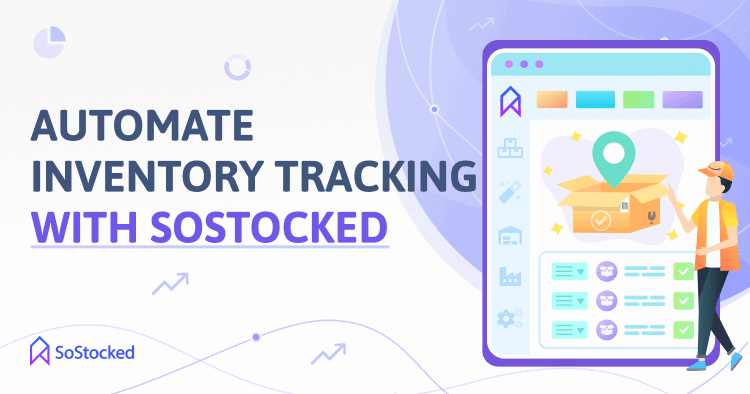
Tracking your shipments can be time-consuming, considering the number of steps, players, and documents involved in this process.
Fortunately, you can use SoStocked to have increased visibility over your shipments as they make their way through the port and into Amazon or your 3PL warehouses. Here are some of the best inventory tracking tools and features that you can use in SoStocked.
Lead Time Management Tools
Designate a default lead time to each of your purchase orders to be able to track it anytime. Once a lead time is assigned, you can build out a workflow to track your inventory order. For example:
Lead Time: 70 Days
- In Production – 30 Days
- Ocean freight – 25 Days
- Ground freight – 10 Days
- Amazon FBA – 5 Days
This workflow also lets you know when your inventory will arrive so you or your ground freight partner can quickly pick it up, helping you avoid detention and demurrage fees.
Order Tracker
This tool helps you track the progress of your shipment from the time a purchase order (PO) is sent to the supplier to shipping it to its destination country. It also features a neat Kanban board that automatically moves POs from In Production > En Route > 3PL warehouse or FBA based on your assigned lead times.
Split Shipments
Sometimes it’s necessary to split a shipment within the same PO when you need to send inventory to two or more separate locations (FBA and 3PL) or in multiple types of shipping (sea and air combination) to avoid stocking out. So, rather than creating two separate POs, you can simply split the shipment within the same PO and instruct your supplier or warehouse to send a portion of the inventory by air and the rest by sea.
Stay In Control Of Your Shipping Costs
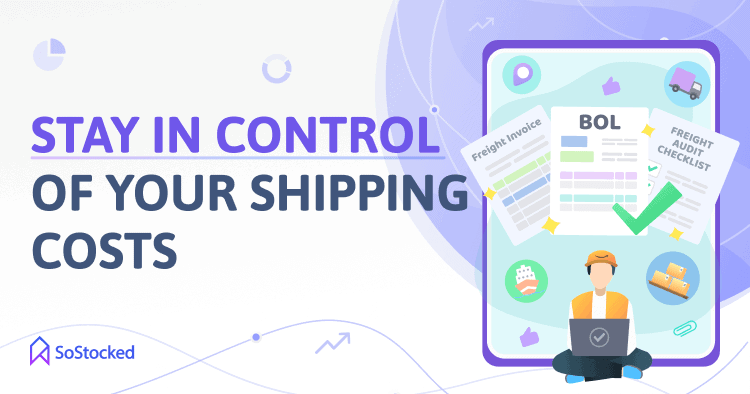
Invoice-matching discrepancies, unethical international trading practices, and price hikes happen all the time. Although they’re beyond your control, it doesn’t mean you can’t do something to lessen their impact.
Understanding and verifying the freight forwarder fees on your invoices and bills of lading is one way to spot potential errors. Keep clear documentation of these errors and get your freight forwarder to explain why some costs don’t add up. File a reimbursement claim for overcharges, duplicate charges, lost or stolen units, and late deliveries to recover some money you lost.
It’s also wise to put an inventory tracking system in place to know the progress of your cargo from the time it goes into production through shipping to delivery. Reviewing your HTS codes at least once a year can also help you lower the duties on your products. Finally, check your freight forwarder’s credentials to avoid the dangers of working with bad actors.
Need more information?
- Send Message: We typically reply within 2 hours during office hours.
- Schedule Demo: Dive deeper into the nuances of our software with Chelsea.
- Join Live Upcoming Webinar: New to Amazon inventory management? Learn three inventory techniques you can implement right away.
 Start Your Free Audit
Start Your Free Audit